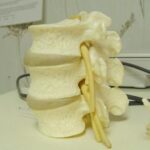Meralgia paresthetica is a very painful type of neuropathic pain that can range from a mild tingling to complete numbness and intense burning, all of the outer thigh. It can affect either one or both legs, and it can seem to “turn off” randomly, then start back up again without any warning. It can be very frustrating, because there is no actual cure for it; there are only a few options which may help to relieve the symptoms. The key word there, however, is may.
If you have or know of someone who has this condition, you know how awful it can be. However, it can seem to come on with no reason, but there are some main triggers of it. It is caused by the lateral femoral cutaneous nerve being compressed by some obstruction, therefore leading to it becoming agitated and therefore inflamed. This causes a decrease in blood flow to the nerve, which decreases feeling in the nerve area and can cause the other symptoms.
Many things, however, can cause this obstruction such as an increase in weight (creating a larger stomach which can compress the nerve) and pregnancy (which also can compress the nerve because of the lumbar spine being curved more forward than normal). Certain traumas that cause damage to the nerve or ligament the nerve runs under can cause similar symptoms, also, and some surgeries can as well, including pelvic osteotomy, iliac crest bone grafting, appendectomy, inguinal lymph node dissection, and others. Some external causes of meralgia paresthetica are tight clothes, braces, carpenter’s belts, belts, and other garments of the sort. As you can see, many different things can cause meralgia paresthetica, but since it’s so hard to treat it really seems very unfair.
If you think you may have meralgia paresthetica and have not seen your primary care physician or neurologist, you may want to know that it can be confused for other conditions, as my case was. To help rule these out, however, your doctor can order for you to have x-rays, electromyography (whereas with meralgia paresthetica findings will be normal, but it’s used to rule out other conditions), and nerve conduction studies. These all help rule out other conditions as well as help diagnose MP, but before they are ordered you will usually just receive a physical exam by a neurologist. If you are found to have meralgia paresthetica, however, there are some options for treatment.
Some possible interventions for meralgia paresthetica, however, are conservative treatments like physical therapy, acupuncture, ultrasound, electrical stimulation, and transverse friction techniques. These may help break up some adhesions that are trapping the nerve. However, in most cases if you try to avoid wearing tight clothing and/or lose any extra weight, the symptoms will become more livable and you may find temporary relief. Don’t overlook this condition, though, as some severe cases do require surgery to release the entrapped nerve.
I suffer from this condition, and it’s very annoying. The only way to describe my symptoms is a tingling feeling or itching that sometimes leads to numbness or burning in my outer thigh, and it happens mainly when I’m laying down, however will happen sometimes at any time of the day. I usually also have aches in my thigh muscle, around the area of where the pain is, and even though I haven’t read anywhere that muscle pain is a symptom I still believe it is. The pain is so intense that it distracts me from daily activities and other important things such as sleeping, and there is no rhyme or reason to why I have it.
I am not overweight, as many sufferers are, and I do not have diabetes or am pregnant, as a large stomach can result in lateral femoral cutaneous nerve compression (the cause of meralgia paresthetica). I saw my primary care physician and she did many tests such as an MRI, which showed nothing but normal conditions, x-rays of my leg, and others. She also believed I may have lupus or multiple sclerosis, and wanted to do blood tests which I immediately shot down. Believing that I didn’t have lupus or MS, I insisted on being seen by a neurologist.
When I did, he told me that I had a compression of the lateral femoral cutaneous nerve of the thigh, also known as meralgia paresthetica. He shared with me that there weren’t many options and definitely no cure, but that I could try cortisone shots to the lateral femoral cutaneous nerve or try an anti-convulsant medicine. Because of the long list of side-effects pf the medicine and the less than 50% chance of relief from the shots, I decided to just ride it out. Even though I sometimes may not get to sleep for an hour or so and feel as if my leg is being burned off, it does come and go. The neurologist told me that it may cure itself randomly, however whenever it goes away it always comes back within a month later.
Another correlation I found with meralgia paresthetica is weather. It may sound odd, but when the weather changes to extremely hot or extremely cold, my symptoms get worse and much more persistent. I don’t know if this is just an uncanny relationship between my body’s reaction to the extreme weather changes or not, but it always happens. My doctor told me that some pain relievers may help relieve some of the pain, but to be careful using ibuprofen because it may cause a sort of dependency where the pain actually gets worse because of it. This may help you if you are a sufferer, but I haven’t tried many pain relievers since acetaminophen seemed not to work for me.
Sources:
MayoClinic.com


